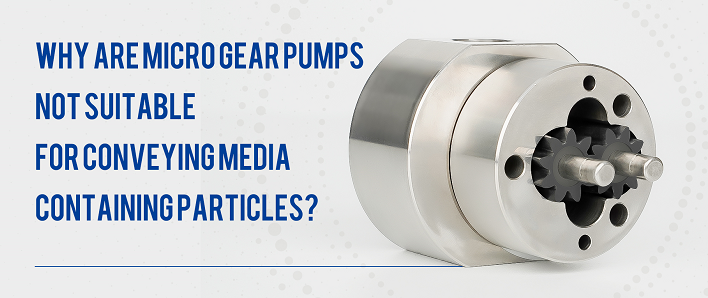Why gear pumps are not suitable for conveying medium with particles
TOPSFLO's MG series micro gear pump can achieve a pressure difference of 10 Bar (1 MPa) when conveying low-viscosity liquids (such as water or other solvents). The minimum clearance in the pump is controlled at around 0.02 mm, which means that particles larger than this size will cause the pump to jam.

Gear pumps are not suitable for conveying granular media. The core reason is:
The conflict between the precision gap structure and the particle characteristics can be analyzed from the following three aspects:
Precision gaps are easily clogged by particles
1. Necessity of gap design Gear pumps reduce internal leakage through tiny gaps (usually only 0.01~0.05mm) between gears and pump bodies, and between gears to improve pressure and efficiency.
The viscosity of the medium affects the size of the gap:
- When conveying low-viscosity liquids (such as water, solvents), the gap needs to be controlled to be smaller in order to suppress the backflow of liquid in the high-pressure area;
- If the medium contains particles, particles larger than the gap size will directly block the gears, causing the pump to fail to operate.
2. Fatal impact of particle size
- Even if the particle size is slightly smaller than the gap, it may get stuck in the gap due to the aggregation effect of irregular shapes (such as edges and corners, flakes), causing mechanical jamming or abnormal noise.
Particles aggravate mechanical wear
1. "Grinding" damage to the meshing surface of gears when the gear pump is working, the tooth surfaces of the driving gear and the driven gear are in direct contact and slide relative to each other, forming a high-stress friction pair gear.
- After the particles enter the meshing area, they will scrape the tooth surface like "abrasives", resulting in:
- The tooth profile accuracy decreases and the pump efficiency decreases; - In severe cases, fatal failures such as tooth surface peeling and tooth breakage occur.
2. Wear of bearings and shafts There is high-speed friction between the bearings (such as sliding bearings) and the shafts of gear pumps. After particles enter, they will:
- Scratches the journal and the inner surface of the bearing, destroying the lubricating film and causing dry friction;
- The acceleration gap expands, causing the pump to vibrate more, increase noise, and even break the shaft.
Particles destroy fluid mechanics
1. Flow and pressure fluctuations When the granular medium flows in the pump cavity, it will destroy the continuity of the liquid due to collision and obstruction, resulting in:
- Instantaneous flow instability, affecting process accuracy (such as metering scenarios);
- Increased pressure pulsation, which may cause pipeline vibration or system safety valve action clearance.
2. Changes in medium characteristics
- Friction between particles and gears and pump bodies may cause the medium temperature to rise, causing fluid changes or chemical reactions (such as flammable medium fluctuations);
- Metal fragments produced by wear are mixed into the medium, which may contaminate the product (such as food and pharmaceutical industries) or aggravate the wear of downstream equipment.
Comparison: Pump type suitable for granular media If the pipeline needs to contain the following granular media, the pump type can be preferred:
Pump type Characteristics:
| Pump type | Characteristics |
| Screw pump | The flow channel is spacious, the gap between the rotor and the stator is large (<1mm) or the fibrous medium |
| Diaphragm pump | No rotating parts, the medium is transported through the reciprocating motion of the diaphragm, completely avoiding particle wear, suitable for high-concentration particles |
| Plunger pump | The plunger reciprocates in the cylinder body, with good sealing performance, suitable for high-pressure working conditions. The particle permeability depends on the valve group design, which needs to be equipped with wear-resistant valve seats and sealing rings, suitable for fine particles (particle size <1mm). |
Summary: Applicable boundaries of gear pumps
The advantage of gear pumps is that they can transport high-pressure and high-viscosity media (such as lubricating oil and syrup), but their precise gap structure makes them extremely sensitive to particles. When selecting a model, you must strictly follow the following:
--Medium particle size < 1/3 pump gap (and particle hardness < pump body material hardness);
--It is preferred to use clean, lubricating liquids, and avoid media containing solids, fibers or corrosive components.
If you need to transport granular media, you need to choose a more suitable pump type (such as a diaphragm pump or screw pump) based on the particle size, concentration and process requirements to balance efficiency and equipment life.


